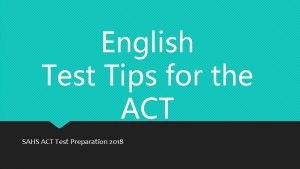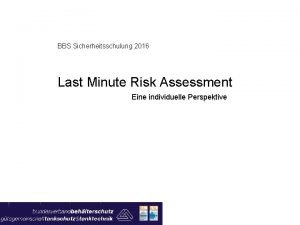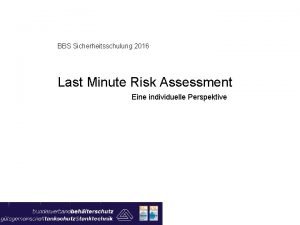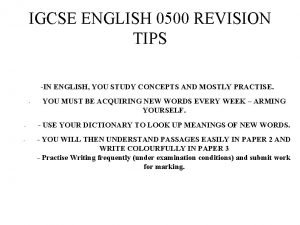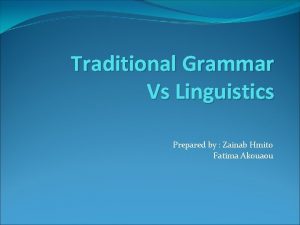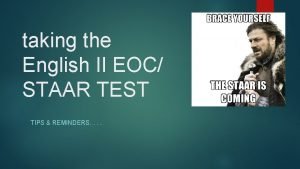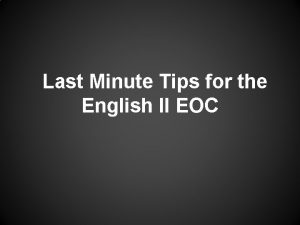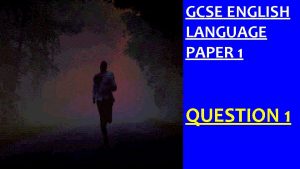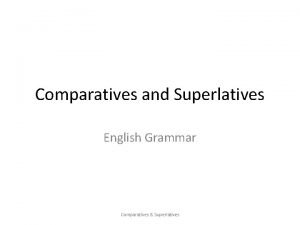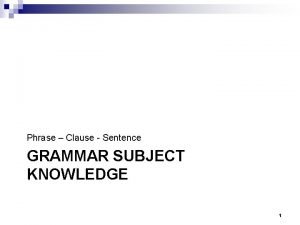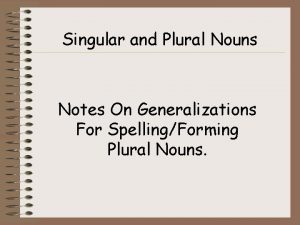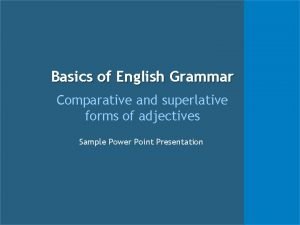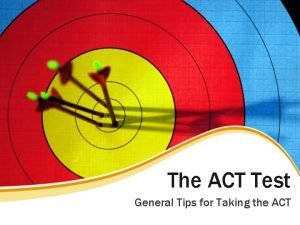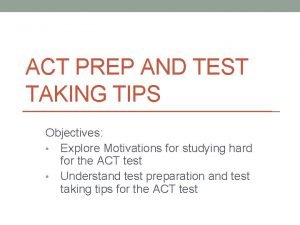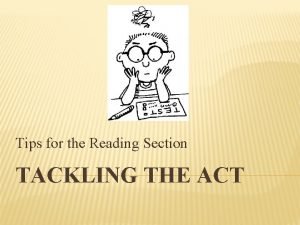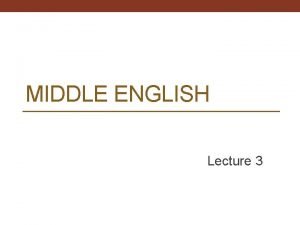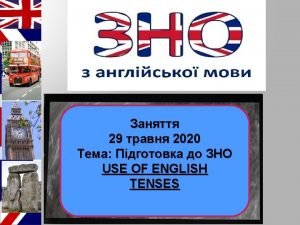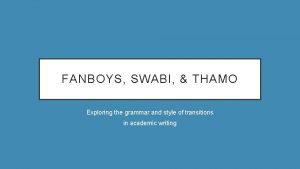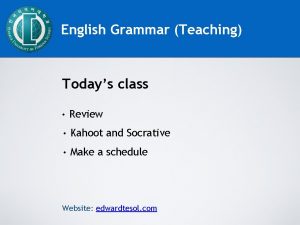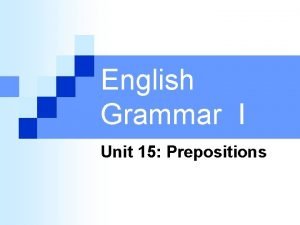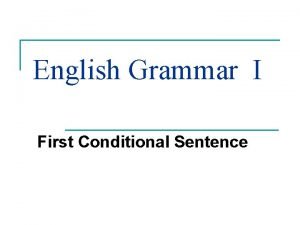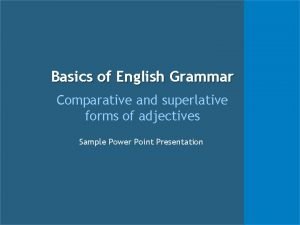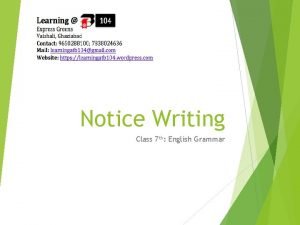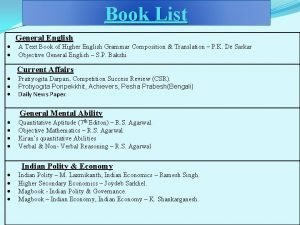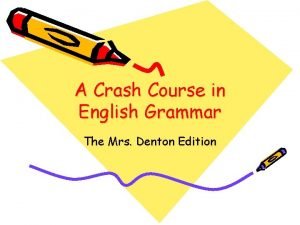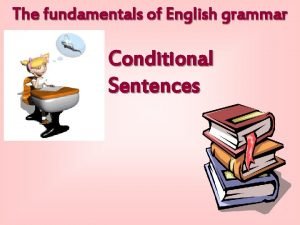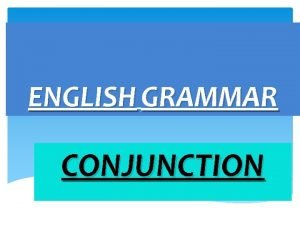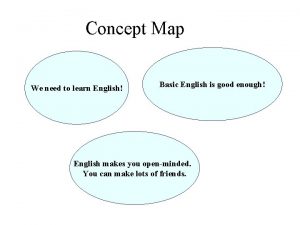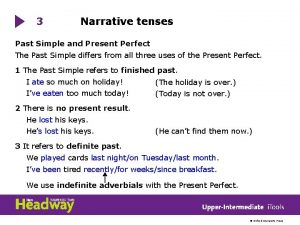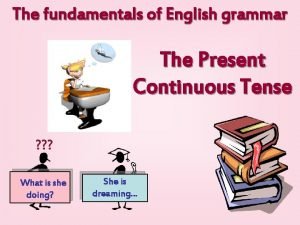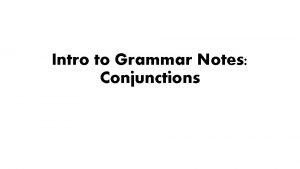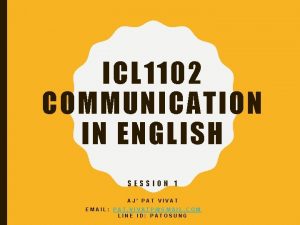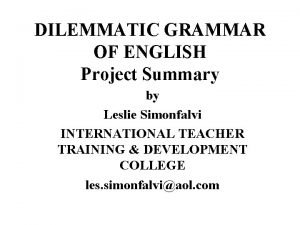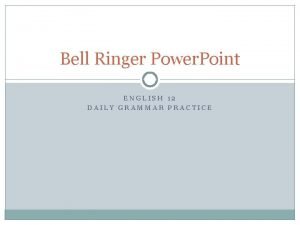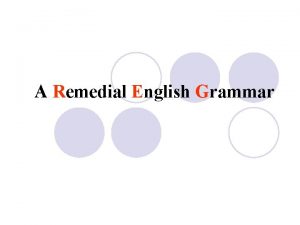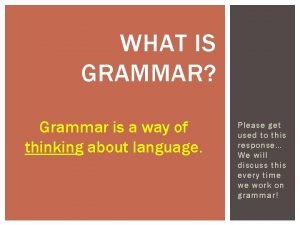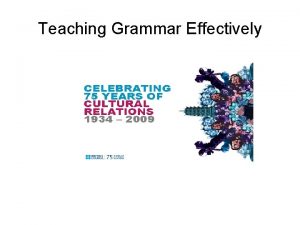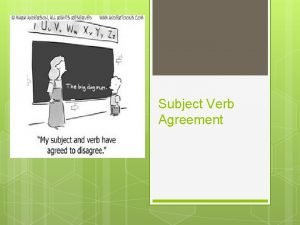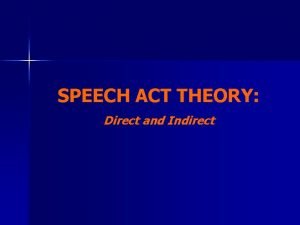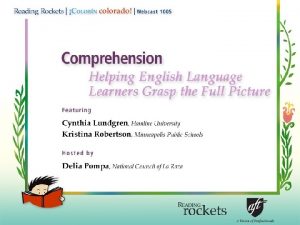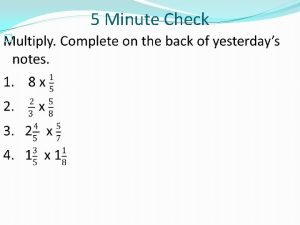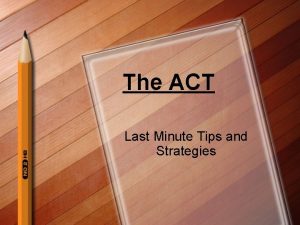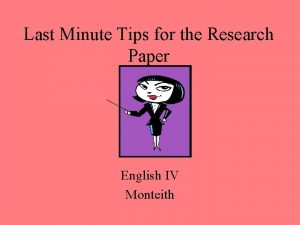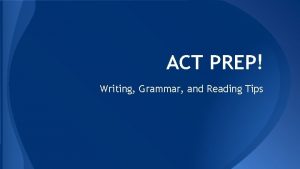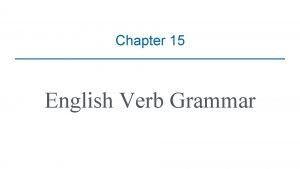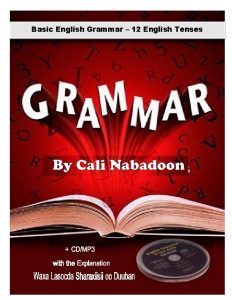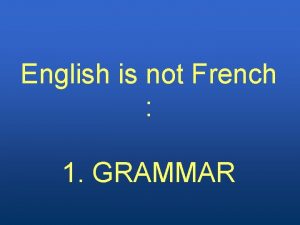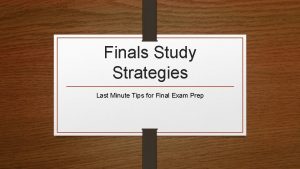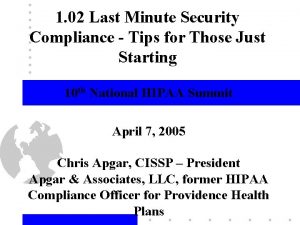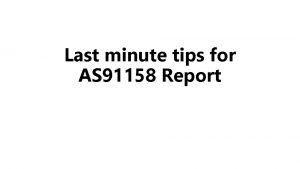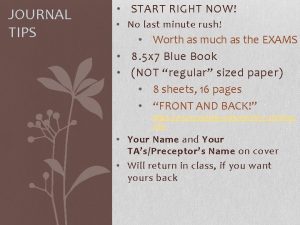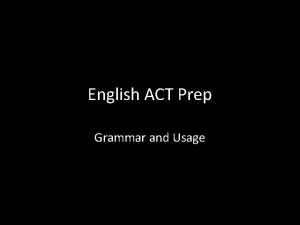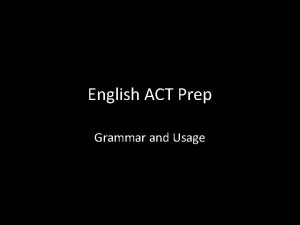ACT Grammar and Last Minute Tips ACT ENGLISH

























































- Slides: 57

ACT Grammar and Last Minute Tips ACT ENGLISH TEST – STRATEGIES HTTPS: //WWW. YOUTUBE. COM/WATCH? V=QF K 3 C 04 BZTI

Punctuation SEMI-COLONS, DASHES, AND COLONS HTTPS: //WWW. YOUTUBE. COM/WATCH? V=PG 7 DV 3 F 2_FG

The Dash — & The Hyphen -

Dash � Sometimes you have some information which needs to be added to a sentence, and that little bit of information is direly – no, deathly – important to that sentence; if it’s a matter of life or death (figuratively, of course), you’ll want the reader to pay attention to that information. Or perhaps you’ve been ranting on about one thing and then suddenly change tack and rant on about something different. In either case, this is where you want to use a dash. � It’s a strong punctuation mark, and it can be compared to the softer parentheses (just as a period compares to a semicolon). � You can use a dash whenever you need to wake your reader up and let them know that the focus is changing.

Why a dash? 1. Parenthetical Information 2. Setting Off Appositives That Contain Commas 3. Concluding A List Of Elements, Focusing Them All Toward One Point 4. Marking Sharp Turns In Thought, Restatements, Amplifications Ø (probably won’t be used on the ACT)

Parenthetical Information �Dashes are used to offset parenthetical information – that is, information which you might put in parentheses. When you use parentheses, though, the emphasis is taken off the parenthetical information and put on the rest of the sentence. When you use dashes (two of them), the emphasis is put on the information within the dashes. �For this usage, do make sure there are two dashes: one on each side of the parenthetical information. Example: Ø While I was shopping – wandering aimlessly up and down the aisles, actually – I ran into our old neighbor.

Appositives That Contain Commas �An appositive is a small section of extra information which is inserted into a sentence for clarification. Commas are usually used to offset the appositive, but if the appositive contains one or more commas, that would get confusing for the reader. �When using an appositive that contains a comma, offset it with dashes, instead. Example: Ø Ø Four of us – Mike, Amanda, Katy, and I– went to the conference last week. Mr. M. glanced surreptitiously at his watch – his gold, diamond -encrusted watch – and suggested the meeting might adjourn for the day.

Concluding A List Of Elements, Focusing Them All Toward One Point �When a sentence begins with an independent clause and ends with a list, you can use a colon between the clause and the list. �When the list comes first, it’s better to use a dash to connect the list to the clause. This helps to take three potentially random things and focus them towards one idea which is easier for the reader to process. Examples: Ø Ø Dishes, laundry, dusting – they’re all done now, and I need a rest. Do this, do that, go here, go there – there’s so much to do that I don’t actually get much accomplished during the day.

Marking Sharp Turns In Thought, Restatements, Amplifications �Dashes can act like little warnings (like yellow road signs) that whatever the writer has been doing is about to change. �Dashes identify a sudden break in the sentence as the writer changes tack, perhaps going entirely in another direction, or perhaps just pausing to insert another thought. �This effect is usually fairly informal, and isn’t recommended for academic writing (as it might look like you don’t know what you’re talking about). Example: Ø Mary, could you – no, Mikey, don’t touch the sharp knife! – Mary, could you please set the table?

Dash vs. Hyphen �A dash is a little line that is written in the middle of the line (not at the bottom: that’s an underscore). It’s longer than a hyphen. �Dashes are used to separate groups of words, not to separate parts of words like a hyphen does.

Hyphens HTTPS: //WWW. YOUTUBE. COM/WATCH? V=LCUOYGK 5 YM

Colon vs. Semi-colon : vs. ; COLONS OFTEN GET CONFUSED WITH SEMICOLONS, BUT THEY HAVE DIFFERENT EFFECTS.

Colon �The colon makes the first part of the sentence unimportant. It’s always the second part of the sentence that will give you the relevant information, although you need the first part of the sentence to tell you that; it’s as if the first part of the sentence is the tattletale. �Colons are used to: make lists Ø Here’s the grocery list: eggs, milk, juice, bread, and fruit. separate one idea from the one which follows Ø I’m soaking wet: I forgot my umbrella.

Colons: Colons look like this: : Colons MUST have an independent clause IN FRONT OF THEM, but they won’t always have them AFTER. Colons are used before a list (if and ONLY if that list comes after an independent clause) Colons can come before a further explanation of something if and ONLY if that extra information comes after an independent clause.

How do I know I need a colon? Colons: Use the “ready? Here it comes!” test with colons � If you have an independent clause, and you want to test whether or not a colon makes sense after the independent clause, say “Ready? Here it comes!” then say the rest of the sentence. If it makes sense, then you need a colon. Independent Clause I have three favorite dog breeds (ready? Here they come…) German Shepherds, Huskies, and Jack Russels. List YOU NEED A COLON!

M. U. G. concepts in this set: Colons: Use the “ready? Here it comes!” test with colons Independent Clause I want a special meal for my birthday____sushi from Further Info the new Japanese restaurant. Do you need a colon?

Colons: NEVER use a colon after the word(s): �am, is, are, was, were �the word because If you see the words “the following”, you will probably need a colon!

Semi-Colon �A semicolon is a punctuation mark used to connect two thoughts or ideas which are somehow similar. Generally, each thought or idea could be used as its own sentence, but the flow of the work may be interrupted by the short, choppy sentences. �Semicolons are used to connect two independent clauses which are related somehow. They work like a soft period, separating the thoughts but keeping the flow of the first sentence. Ø Ø I’m looking for my book; where do you suppose I put it? The students had been advised against walking alone at night; however, Cathy decided walking wasn’t dangerous if it was early in the evening.

Commas HTTPS: //WWW. YOUTUBE. COM/WATCH? V=G 7 NKLS 8 PMZO

4 Comma rules for ACT/PLAN �Use a comma to separate non essential information from the sentence. Ex. Julie, my best friend, met me in middle school. �Use a comma after introductory words, phrase, and clauses. Ex. Although Juan promised to meet me by the lockers, I have no idea where he is.

4 Comma rules for ACT/PLAN �Use a comma to separate items in a series. Ex. I like to shop for shoes, jeans, and make up. �Use a comma between two long, independent clauses when conjunctions such as and, or, but, for, nor to connect them. Ex. I wanted to learn to skateboard this summer, but I decided to take dance lessons instead.

Comma Splices �https: //www. youtube. com/watch? v=PLAU 8 Ls. RR 6 k

Apostrophes HTTPS: //WWW. YOUTUBE. COM/WATCH? V=MY 6 OGVKHNFY SINGULAR: THE DOG’S PLURAL: THE DOGS’ SINGULAR: MRS. BURNS’S PLURAL: THE BURNS’

Who vs. Whom





Examples

Examples


Who vs. Whom Who should be used to refer to the subject of a sentence. Whom should be used to refer to the object of a sentence. �When in doubt, try this simple trick: If you can replace the word with ‘he’ or ‘she, ’ use who. If you can replace it with ‘him’ or ‘her, ’ use whom. Here are two examples: Ø Who ate my sandwich? (Did he eat my sandwich? Did she eat my sandwich? ) Ø Whom should I talk to about labeling food in the refrigerator? (Should I talk to him? Should I talk to her? )

Who’s Vs. Whose

Who’s Vs. Whose �Who’s is a contraction of who is or who has. �Whose is the possessive form of who or which. Think of it this way: �If you were to replace it with who is or who has, would its meaning change? If no, you want who’s. If yes, you want whose.

Examples �Here a few examples of the words used correctly: �Celebrity birthdays: Who’s another year older Jan. 11? [OC Register] �Who’s Renting What on Netflix? [World’s Strangest] �Whose ass should I kick at ping-pong? [Warming Glow] �I am convinced this really is an idea whose time has come. [FDL]

Commonly Misused Words

� Accept is a VERB � Except can be used as a preposition or as a conjunction. • If you are using the word as an action, then you need to use the word “accept. ” • I accept your apology. • I did everything except my English homework.

These two words are very similar. Just remember, if it is something you can COUNT, then you use FEWER. If there are too many to be counted, then you use LESS.

• If you can substitute the words “it is” then you should use “It’s. ” • Its (no apostrophe) shows possession

• In present tense, lie and lay both mean to sit or recline. • “Lie” does not have an object. • Basically, that means it will never be followed by a noun. • You cannot “lie” something. • Example: I lie down on the couch to watch TV. • “Lay” has an object. • This means a noun will follow it. • The subject of the sentence is performing the action “lay” on something else. • Example: James lay the book on the desk.

• To make your life more confusing, the past tense of the word “lie” is “lay. ” • Example: He lay in bed last Saturday because he was sick.

• If you can substitute the words “you are” then you should use “you’re. ” • Your (no apostrophe) shows possession If someone says, “thank you, ” then you say back, “YOU’RE welcome. ” Don’t ever write it incorrectly again.

Subject-Verb Agreement HTTPS: //WWW. YOUTUBE. COM/WATCH? V=0 E MLVXINBUK

Subject/Verb Agreement �All complete sentences must have a subject and a verb. �The subject of a sentence is ALWAYS a noun. It is the noun in the sentence that is DOING something. �The verb is what the subject is doing. �Subjects and Verbs have to “agree” or “match” each other in order for the sentence to be correct.

Practice 1. 2. 3. 4. 5. 6. 7. 8. 9. 10. 11. 12. 13. 14. 15. People who (live, lives) in poverty often do not even have television or newspapers. Traditionally, college students (has, have) been very active in politics. There (is, are) both men and women at the meeting. The students in my class (has, have) very poor work habits. Each of you (has, have) an equal chance to make good grades. All of the children (was, were) hunting Easter eggs in the garden. A notebook and a pen (is, are) lying on the desk in the library. My son, along with two friends, (is, are) coming for the weekend. Sitting on the sofa (was, were) two students from Thailand. Either the workers or the manager (is, are) coming to the conference. Not only the students, but also the teacher (has, have) been unhappy. Everybody (hate, hates) to take tests. Knowledge gained after long study (disappear, disappears) rapidly from our minds. One of my greatest worries in college (was, were) that I would study hard and still flunk important tests. Georgia Southern University (provide, provides) some scholarships for the students.

Misplaced Modifiers

Misplaced or incorrect modifiers: � Introductory participial phrases must modify the subject. � Modifiers should not be “misplaced” in a sentence so that what is being modified is unclear. Example: The Beast returns to the castle where he keeps Beauty imprisoned, dying slowly from a wicked curse. Correction: Dying slowly from a wicked curse, the Beast returns to the castle where he keeps Beauty imprisoned. (Placement of the phrase in the first sentence creates confusion; it seems as if Beauty if dying from a wicked curse. )

READING ACT READING TEST STRATEGIES

Testing Strategies SKIMMING AND SCANNING

How is 'skimming' different to 'scanning'? � Skimming is used to obtain the gist (the main idea) of a piece of text. E. g. Use skimming to get the gist of a page of a textbook to decide whether it is useful and should therefore be read more slowly and in more detail. � Scanning is used to obtain specific information from a piece of text. E. g. Use scanning to find a definition on a textbook page.

What is skimming? Skimming is a reading technique that can help you to: • • read more quickly decide if the text is interesting and whether you should read it in more detail Skimming is a fast reading technique. Use it to obtain the gist of a piece of text (i. e. to quickly identify the main ideas in the text).

Main Idea � The Main Idea is what the text is mostly about. It is the most important thing in the text. � It is also called the gist.

How do you skim read? 1. Read the title, subtitles and subheading to find out what the text is about. 2. Look at the pictures to give you further information about the topic. 3. Read the first and last sentence of each paragraph. 4. Don't read every word or every sentence. Let you eyes skim over the text, taking in key words.

What is scanning? Scanning is a fast reading technique. It's a way of reading to look for information in a text. Scanning can be used to look up a phone number, read through the small ads in a newspaper, or for browsing TV schedules, timetables, lists, catalogues or web pages for information. For these tasks you don't need to read or understand every word. Scanning is also useful when studying or looking to find information from a book or article quickly as there is not always time to read every word.

How do you Scan read? 1. Don't try to read every word. 2. Let your eyes move quickly across the page until you find what you are looking for. 3. Use clues on the page, such as headings and titles, to help you. 4. In a dictionary, phone book, or article: � Use the 'header' words to help you scan. You can find these in bold type at the top of each page.

Hints and Tips for Better Scanning If you are reading for study or testing, start by focusing on questions that you want to answer. Doing this can focus your mind and help you find the facts or information that you need more easily. There are many ways to practice scanning skills. Try looking up a favorite recipe in the index of a cookbook, search for a plumber in your local Yellow Pages, or scan web pages on the Internet to find specific information.

Scanning � You can scan a text to find details that support the main idea. � Details are facts or ideas that tell about or prove the main idea.
 60 min in seconds
60 min in seconds Act english tips
Act english tips Act english grammar
Act english grammar Last minute risk analysis karte
Last minute risk analysis karte Last minute risk analysis vorlage
Last minute risk analysis vorlage Bbs sicherheitsschulung
Bbs sicherheitsschulung Last minute bids
Last minute bids Last minute risk assessment
Last minute risk assessment Cram last minute
Cram last minute Right linear grammar to left linear grammar
Right linear grammar to left linear grammar Igcse
Igcse Advantages of traditional grammar
Advantages of traditional grammar Unrestricted grammar example
Unrestricted grammar example Right linear grammar
Right linear grammar Staar english 2 2019 answer key
Staar english 2 2019 answer key English eoc tips
English eoc tips Language
Language Worry superlative
Worry superlative Phrase and clause
Phrase and clause Would rather grammar rules
Would rather grammar rules Singular and plural nouns examples
Singular and plural nouns examples Funny in comparative and superlative
Funny in comparative and superlative Tips on taking the act
Tips on taking the act Tips for taking the act
Tips for taking the act Reading act tips
Reading act tips Middle english grammar
Middle english grammar English
English Basic english grammar test
Basic english grammar test Example of swabi
Example of swabi V present
V present Kahoot grammar review
Kahoot grammar review Unit 15 grammar the passive the causative
Unit 15 grammar the passive the causative First conditional grammar rules
First conditional grammar rules Syllable english grammar
Syllable english grammar Format of notice writing class 7
Format of notice writing class 7 English grammar in use oxford
English grammar in use oxford A text book of higher english grammar
A text book of higher english grammar English grammar crash course
English grammar crash course Adjective classification
Adjective classification If will grammar
If will grammar Imperative form
Imperative form Whats a coordinating conjunction
Whats a coordinating conjunction Concept mapping in english grammar
Concept mapping in english grammar Narrative tenses nedir
Narrative tenses nedir What simple tenses are the fundamentals of english grammar
What simple tenses are the fundamentals of english grammar Abbisawawuwu
Abbisawawuwu Icl1102
Icl1102 English grammar project
English grammar project Grammar bell ringer
Grammar bell ringer What is adverb clause in english grammar
What is adverb clause in english grammar A remedial english grammar
A remedial english grammar S-lv-pn
S-lv-pn Recursion linguistics
Recursion linguistics Grammar subject verb agreement
Grammar subject verb agreement Acts
Acts Grammatical signals
Grammatical signals Subordinate relative clause
Subordinate relative clause What is comprehension
What is comprehension

